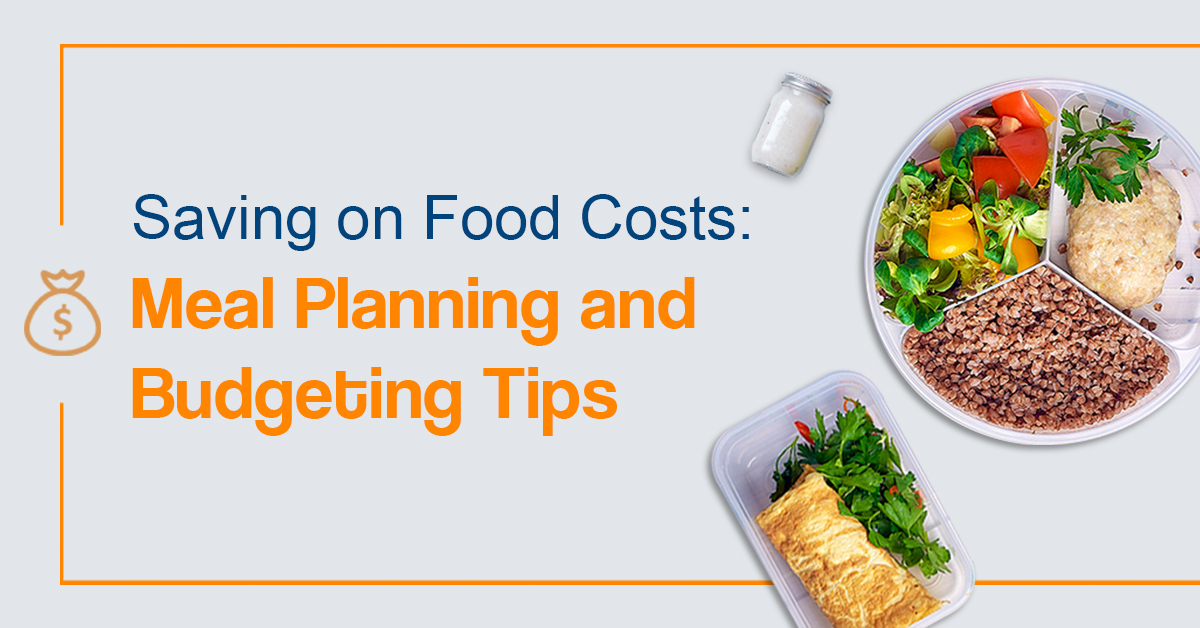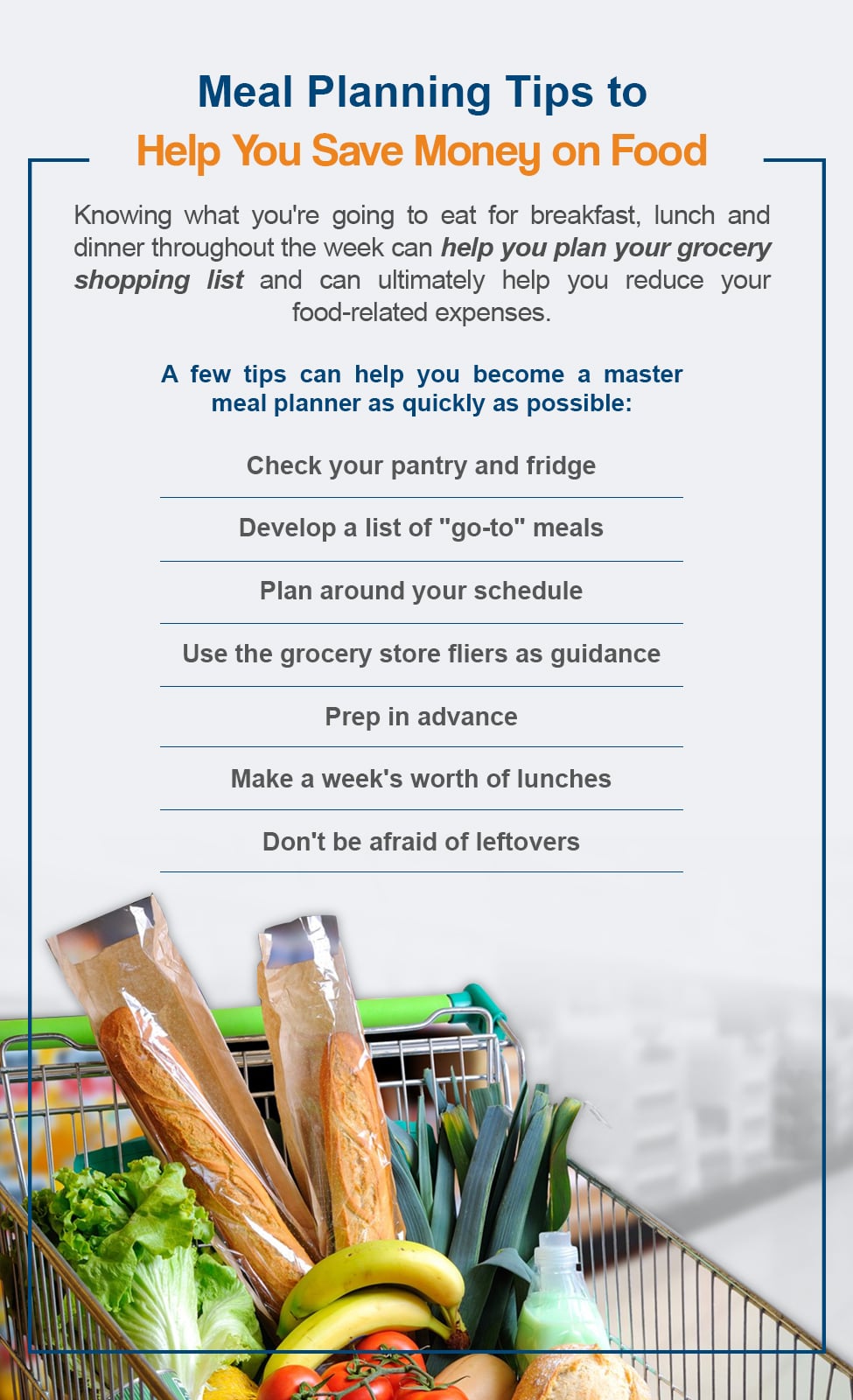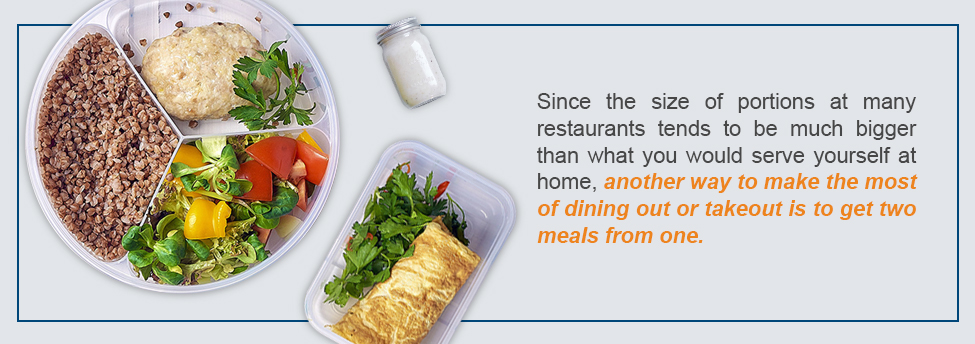Saving on Food Costs: Meal Planning and Food Budgeting Tips

Jump ahead:
How Much Does Food Cost?
How to Eat Healthily on a Low Budget
How to Save Money on Food: Planning Your Grocery Trips With a Budget in Mind
Understanding the Price Tag Can Help You Save on Food Costs
Meal Planning Tips to Help You Save Money on Food
Home Cooking vs. Restaurant Meals: Which Is Cheaper?
Are Meal Subscription Boxes Worth It?
If you’re like many people, you might be taking a close look at your regular spending and wondering where you can cut back to save money and reach your financial goals. While some expenses, like your house payment or your car payment, might be fixed, others offer a bit more flexibility. One of those flexible, or variable expenses, is your food budget.
Whether you currently dine out or get takeout most nights of the week or cook at home most of the time, there are plenty of ways to trim the fat from your budget and cut back on your food costs. Learning what healthy foods offer the best value for money, meal planning and how to make the most of the grocery store can all help you save money on food costs.
How Much Does Food Cost?
Before you start finding ways to cut back on your food budget, it’s essential to have a sense of how much you’re spending each month and to see how your family’s spending compares to national averages.
The United States Department of Agriculture (USDA) puts together food plans that reflect how much people spend, on average, for a nutritious diet. The USDA separates the food plans into four categories:
- Thrifty (least expensive)
- Low-Cost
- Moderate-Cost
- Liberal (most expensive)
It also sorts the plans based on family size and the age of people in a household:
- 1 couple, male and female, aged 19-50: $387.90/month (thrifty) – $769.20/month (liberal)
- 1 couple, male and female, aged 51-70: $367.90/month (thrifty) – $718.50/month (liberal)
- A family of four, male and female couple aged 19-50, two children under age 6: $566.30/month (thrifty) – $1103.80/month (liberal)
- A family of four, male and female couple age 19-50, two children between age 6 and 11: $649.60/month (thrifty) – $1294.00/month (liberal)
If your goal is to save on food costs, it makes sense to bring your monthly food spending in line with either the USDA’s Thrifty plan or Low-Cost plan. Read on to learn more about budgeting for food.
How to Eat Healthily on a Low Budget
Once you have an understanding of the cost of food on a low-cost or thrifty plan, you might wonder how you can reduce your spending and bring your overall food costs down to the average based on your family size and age.
It can seem that the most affordable foods at the grocery store are also the least healthy. Chips, canned soups and candies are all very affordable, but not exactly the best thing when it comes to nutrition and overall health.
While packaged foods might seem cheaper than fresh produce, whole grains and other healthier options, in reality, many of the foods that are best for your health are also reasonably affordable. Some examples of foods that are good for you and good news for your wallet include:
- Eggs
- Brown rice
- Pasta
- Beans, dried or canned
- Frozen vegetables
- Fresh vegetables and fruits in season
- Canned tomatoes
How to Save Money on Food: Planning Your Grocery Trips With a Budget in Mind

Saving money on your food bill means more than understanding what foods are wallet-friendly and waist-friendly. It also means understanding how to make the most of your time at the grocery store so you don’t overspend. Here’s a list of 5 tips to keep your spending at the store in line with your budget’s limits:
1. Refer to the Fliers
Many grocery stores produce sales fliers each week, highlighting what items are marked down. When you’re planning your grocery list, it helps to take a look at the circulars to see what’s on sale that week. It might be worthwhile to stock up on certain items, such as canned or dried beans or frozen vegetables if they are a reasonable price one week.
2. Stock up on Coupons
Coupons can be a double-edged sword when it comes to reducing your grocery expenses. If you can find coupons for items you usually buy, then you’re good to go. But many coupons are for items that you might not plan on buying or wouldn’t even consider without the coupon. The best way to approach coupon use is to cut out or print out coupons only for items you use regularly.
If you don’t need the item that you have a coupon for immediately, one way to get the most value for your money is to save it until the food goes on sale. Just pay attention to the expiration date and make sure you use it before then.
3. Make a List
Going shopping with a list keeps you from buying things you don’t need and that are likely to throw your budget off balance. Using a list also makes you less likely to forget an item you need, which means you’re less likely to have to return to the store. The fewer times you have to go to the grocery store, the less temptation there will be to spend.
4. Shop Alone and Prep for Your Trip
Spouses and children can make grocery shopping and sticking to a budget and your list a challenge. Your kids might ask you for things that aren’t on the list or that are beyond your budget. In some cases, your children might add items to the cart without you noticing until you get up to the checkout aisle.
If you go to the store alone, it’s much easier to stay focused and only buy the things you know you need, because you put them on the list. That said, there is still a chance that you’ll get tempted by a sale item or a display of tasty-looking baked goods at the store. To reduce the likelihood of impulse buys, it’s a good idea to shop on a full stomach.
Have a meal or a snack before you go to the store to make treats and snacks look less tempting. You might want to listen to a podcast or music as you shop so you are less likely to get distracted by an eye-catching in-store display.
5. Shop at “Unpopular” Times
If you’ve ever shopped at a grocery store on a weekend afternoon, you know that it can be a challenge. During busy periods, stores are crowded, lines are long, and the entire process takes more time. You might get cranky or tired, which can make you more likely to give in to impulse buys.
In contrast, when you go to a grocery store at night or on a weekday morning, the aisles are practically empty. You have room to find the items you need, and it takes much less time to navigate the store. The entire experience is usually a lot more pleasant, and you spend less time in the store, which can mean you get in and out without going over budget.
Understanding the Price Tag Can Help You Save on Food Costs
There’s more to the price tag at the grocery store than the retail price. The tags printed on the shelf below the item you’re buying not only let you know what you’ll spend to purchase one of those items, but they also give you an idea of how the price of a particular brand or product compares to similar foods and can help as you’re sticking to your budget for food.
Each tag has the retail price or the sale price printed on it. The tags also have the unit price printed, which is how much an item costs per ounce, pound or another unit of measure.
Looking at the price tag of two options for Greek yogurt, you might see that one has a retail price of $0.80 for an 8-ounce container. The unit price is $0.10 per ounce. Meanwhile, a quart (32 ounces) of Greek yogurt costs $2.75. The unit price is $0.085 per ounce. Although you pay more overall for the quart-size container, you pay less per ounce.
Understanding the difference in unit price can come in handy when you need to buy multiple amounts of an item. If you only need a single 8-ounce container of yogurt, it doesn’t make financial sense to buy 32 ounces, as the extra yogurt will likely go bad. But if you eat yogurt daily, then buying the bigger, less expensive container will provide a better value.

Meal Planning Tips to Help You Save Money on Food
Knowing what you’re going to eat for breakfast, lunch and dinner throughout the week can help you plan your grocery shopping list and can ultimately help you reduce your food-related expenses. As an added benefit, meal planning also eliminates dinner indecision and can keep you from calling for takeout because you don’t know what to eat.
Getting into the habit of planning meals and maximizing your meal planning so you spend less money at the store and less time in the kitchen does take some time and effort. A few tips can help you become a master meal planner as quickly as possible:
- Check your pantry and fridge. Before you start thinking about what you need to make and buy for the coming week, check to see what ingredients you already have on hand. You might have plenty of ingredients or enough to plan a full week’s worth of meals without having to spend much money at the store.
- Develop a list of “go-to” meals. Don’t feel as if you have to find and try new recipes each week as part of your meal plan. Focus on making meals your family likes and that are easy to put together on busy weeknights. Once you have a list of “go-to’s,” you might find that meal planning becomes a snap.
- Plan around your schedule. Some nights are busier than others, and you probably don’t want to plan elaborate, multi-step meals for those nights. Make your meal plan fit your life — don’t try to fit your life to your meal plan.
- Use the grocery store fliers as guidance. The fliers you get from the grocery store can be a source of inspiration for your weekly meals. Look at what types of meats are on sale and what vegetables are marked down, and plan a few meals that center around this week’s sale items.
- Prep in advance. Preparing as much of your food in advance as possible will also help you avoid food waste and will help you stick to your plan. Make food prep part of your weekly grocery shopping. Once you get home from the store, set about chopping up vegetables, browning meat and cooking grains or beans.
- Make a week’s worth of lunches. If you and your family members bring lunches to work or school, make a full week’s worth of lunches all in one fell swoop. You’ll save time in the long run and will be less likely to rush out and buy lunch because you didn’t have one ready to go.
- Don’t be afraid of leftovers. When it comes to saving money on food, leftovers can be your best friend. When you’re preparing meals for the week ahead, you can double a recipe and freeze the extra for another meal later in the month. Another option is to have whatever is left over from dinner for lunch the next day.
Home Cooking vs. Restaurant Meals: Which Is Cheaper?

In 2017, the average household spent $7,729 on food. On average, households spent $3,365 on food outside of the home and $4,363 on food at home. Both spending on food at home and food away from home increased between 2016 and 2017 and between 2015 and 2016.
Generally, preparing meals at home is less expensive than ordering food at a restaurant or getting food to-go or delivered. Although there are outliers, such as $1 hamburgers on the value menus at some fast food restaurants or $5 burrito specials, food at restaurants typically costs around five times more than food you prepare and cook at home.
You don’t have to give up going out to eat or getting takeout or delivery, as there are ways to get the most for your money when you get food from a restaurant. You can take advantage of specials and coupons. Many places offer happy hour specials on food as well as drinks, so you can save money by going out to eat earlier in the evening.
Since the size of portions at many restaurants tends to be much bigger than what you would serve yourself at home, another way to make the most of dining out or takeout is to get two meals from one. Pack up half of your meal for lunch the next day before you dig in or ask the server to bring you a takeout container right at the beginning of the meal.
Are Meal Subscription Boxes Worth It?
Meal subscription boxes, which deliver the recipes and ingredients needed for two or more meals directly to your door, might look like an excellent way to get in the habit of making dinner at home. The boxes usually feature only the amounts needed to prepare a particular recipe, so you don’t have to worry about buying a full jar or bottle of an esoteric ingredient only to have the rest go to waste.
Whether meal kits save you money or not depends on your usual eating habits and the brand you end up buying. One comparison of the cost of meal kits versus grocery store groceries found that the costs were nearly identical in some cases and that grocery store ingredients were cheaper in others.
If you currently eat at restaurants or get takeout a lot and are looking for a way to cook more at home, signing up for a subscription service can be a good first step. Many services offer discounts to first-time customers, which can help you save more. As you get more comfortable in the kitchen and with planning your meals, you can wean yourself off the subscription box and focus more on planning your grocery list and meals from scratch.

Get More Advice From Mid Penn Bank
Once you’ve found a way to get on top of your food spending through food budgeting and planning, you might want to look for other ways to cut costs and save for your financial goals. Check out the rest of our blogs for more tips and advice on saving money and sticking to a budget.
Share:
Disclosures
The material on this site was created for educational purposes. It is not intended to be and should not be treated as legal, tax, investment, accounting, or other professional advice.
Securities and Insurance Products:
NOT A DEPOSIT | NOT FDIC INSURED | NOT BANK GUARANTEED | NOT INSURED BY ANY FEDERAL GOVERNMENT AGENCY | MAY LOSE VALUE
